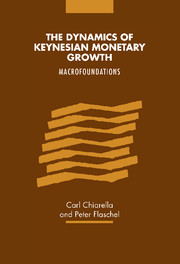Book contents
- Frontmatter
- Contents
- List of figures
- Foreword by Richard H. Day
- Preface
- Acknowledgments
- Notation
- General introduction
- 1 Traditional monetary growth dynamics
- 2 Tobinian monetary growth: the (neo)Classical point of departure
- 3 Keynes–Wicksell models of monetary growth: synthesizing Keynes into the Classics
- 4 Keynesian monetary growth: the missing prototype
- 5 Smooth factor substitution: a secondary and confused issue
- 6 Keynesian monetary growth: the working model
- 7 The road ahead
- References
- Author index
- Subject index
Foreword by Richard H. Day
Published online by Cambridge University Press: 22 September 2009
- Frontmatter
- Contents
- List of figures
- Foreword by Richard H. Day
- Preface
- Acknowledgments
- Notation
- General introduction
- 1 Traditional monetary growth dynamics
- 2 Tobinian monetary growth: the (neo)Classical point of departure
- 3 Keynes–Wicksell models of monetary growth: synthesizing Keynes into the Classics
- 4 Keynesian monetary growth: the missing prototype
- 5 Smooth factor substitution: a secondary and confused issue
- 6 Keynesian monetary growth: the working model
- 7 The road ahead
- References
- Author index
- Subject index
Summary
In his effort to reorient economic theory so that it might offer an explanation of severe and prolonged recessions and insights concerning the possibilities and limitations of fiscal and monetary policies for dealing with them, Keynes introduced two factually based assumptions: first, price and wage stickiness; second, independently determined savings and investment variables. In developing the implications of these two facts, Keynes exploited the concept of demand, not at the usual level of the market for a single good, but at the level of the entire economy for the aggregate of all goods. Thus, for example, instead of an Engle curve for a single good, which gives the demand for a good in terms of real income, he exploited the dependence of aggregate demand for all goods on income, that is, the consumption function. With the real money rate of interest as the only endogenously determined price – in this case the price (or opportunity cost) of using money as an idle balance – the money market is seen to play a potential role; potential, because its role depends on sensitivity to interest rates on the markets for goods and money.
Although his analytical derivations were static and focused on a new kind of persistent unemployment situation, Keynes had in mind a dynamic theory. He fully intended to illuminate the tendency of the market economy to fluctuate due to the interactions between the monetary and real goods sectors.
- Type
- Chapter
- Information
- The Dynamics of Keynesian Monetary GrowthMacro Foundations, pp. xv - xviiPublisher: Cambridge University PressPrint publication year: 2000



